Influence of Headset, Hearing Sensitivity, Flight Workload, and Communication - PowerPoint PPT Presentation
1 / 32
Title:
Influence of Headset, Hearing Sensitivity, Flight Workload, and Communication
Description:
Influence of Headset, Hearing Sensitivity, Flight Workload, and Communication Signal Quality on Flight Performance and Communications: An Army Black Hawk – PowerPoint PPT presentation
Number of Views:70
Avg rating:3.0/5.0
Title: Influence of Headset, Hearing Sensitivity, Flight Workload, and Communication
1
Influence of Headset, Hearing Sensitivity,
Flight Workload, and Communication Signal Quality
on Flight Performance and Communications An Army
Black Hawk Helicopter Simulator Experiment
2
Disclaimer
- The views, opinions, and/or findings contained in
this report are those of the author(s) and should
not be construed as an official Department of the
Army position, policy, or decision, unless so
designated by other official documentation.
Citation of trade names in this report does not
constitute an official Department of the Army
endorsement or approval of the use of such
commercial items.
3
Acknowledgments
- Dr. John Casali
- Dissertation committee members
- Bose, Corp.
- CEP, Inc.
- USAARL
- Participating pilots
4
Background
- Challenges to Army rotary-wing pilots
- Noise
- Communication demand
- Flight workload
- Decreased hearing sensitivity
5
Background
- Current approaches to meeting challenges
- Hearing protection
- Passive earplugs
- Communication devices
- Communications earplug (CEP)
- Active noise reduction (ANR)
- Hearing loss waivers
- Estimated 10 of aviators
6
Background
Class 500 Hz 1000 Hz 2000 Hz 3000 Hz 4000 Hz 6000 Hz
1/1A 25 25 25 35 45 45
2/2F/3/4 25 25 25 35 55 65
- Pure tone air and bone conduction testing
- Tympanometry
- Acoustic reflex testing
- Speech reception threshold
- Speech discrimination, monaurally at 40dBSL, and
binaurally at most comfortable listening level
(MCL) - In-flight evaluation
7
Independent Variable Headset Configuration
8
Independent Variable Flight Workload
(Perceptual)
9
Independent Variable Flight Workload
(Psychomotor)
Low workload Straight and level flight followed by turns to various headings
Medium workload Straight and level flight followed by turns to various headings combined with altitude changes
High workload Straight and level flight followed by turns to various headings combined with altitude and airspeed changes
10
Independent Variable Flight Workload
(Communication)
Low workload One-part radio command Ex. Turn right heading 270. Read-back task during maneuver
Medium workload Two-part radio command Ex. Turn right heading 290, climb and maintain 2500. Read-back task during maneuver
High workload Three-part radio command Ex. Turn right heading 270, climb and maintain 2500 while decelerating to 100 knots. Read-back task during maneuver
11
Independent Variable Signal Quality
- Three levels
- Earphone output signal quality was manipulated
and quantified with the Speech Intelligibility
Index (SII) method of predicting speech
intelligibility - SII levels
- 0.4 (poor)
- 0.6 (average)
- 0.8 (good)
12
Blocking Variable Hearing Levels
- 1. Audiometric pure-tone air-conduction
thresholds not exceeding 25 dBHL at 500, 1000, or
2000 Hz, not exceeding 35 dBHL at 3000 Hz, and up
to 55 dBHL at 4000 Hz in either ear - 2. Audiometric pure-tone air-conduction
thresholds exceeding 25 dBHL at 500, 1000, or
2000 Hz, exceeding 35 dBHL at 3000 Hz, and
exceeding 55 dBHL at 4000 Hz
13
Dependent Measures
- Flight control performance
- Heading deviation
- Altitude deviation
- Airspeed deviation
- Communications intelligibility (ATC readbacks)
- Subjective workload measure
- Subjective situation awareness measure
- Subjective ratings of headset comfort and speech
intelligibility
14
Participants
- Active duty, Department of the Army civilians,
and contract helicopter pilots - Instrument rated
- Current full flying duties flight physical
- Had flown a military helicopter or military
simulator within the past year
15
Participant Demographics
Group 1 Group 2
Age range 20-51 33-66
Age median 31 52.5
Age mean 33.4 50.2
Flight hours range 75-12,000 1,100-11,000
Flight hours median 200 4350
Flight hours mean 1678.5 4770
16
Mean Hearing Levels
RIGHT 250Hz 500Hz 1kHz 2kHz 3kHz 4kHz 6kHz 8kHz
Group 1 9.0 7.0 6.0 4.0 9.0 10.5 14.0 11.0
Group 2 13.0 14.5 19.0 29.5 41.0 51.5 51.5 54.5
LEFT 250Hz 500Hz 1kHz 2kHz 3kHz 4kHz 6kHz 8kHz
Group 1 8.5 7.5 7.5 6.0 12.0 17.0 15.5 15.0
Group 2 18.5 19.5 22.5 30.5 54.5 67.5 69.5 69.0
17
Apparatus
18
Results
- Flight performance
- Heading deviation
- Altitude deviation
- Airspeed deviation
- Communications intelligibility
- Workload
- Situation awareness
- Headset comfort/speech intelligibility
19
Flight Performance
- Altitude deviation Interaction effect of
workload/signal quality
20
Flight Performance
- Airspeed deviation Interaction effect of
- workload/signal quality
21
Flight Performance
- Airspeed deviation Interaction effect of
group/headset
22
Communications Intelligibility
- ATC readbacks Interaction effect of
- workload/signal quality
23
Communications Intelligibility
- ATC readbacks Interaction effect of
group/headset
24
Workload
- Modified Cooper-Harper Interaction effect of
signal quality/workload
25
Workload
- Modified Cooper-Harper Interaction effect of
group/headset
26
Workload
- Modified Cooper-Harper Interaction effect of
- group/workload
27
Situation Awareness
- SART Interaction effect of group/headset
28
Situation Awareness
- SART Interaction effect of group/workload
29
Conclusions
- Workload level, signal quality level, and headset
choice influence pilot performance significant
difference trends - between low and medium workload
- between average and poor signal quality
- with high workload/poor signal quality conditions
- with hearing impaired group using passive
headset/passive earplug combination
30
Limitations of Research
- No co-pilot
- Artificially increased primary pilot workload
- Single ATC radio
- Artificially decreased primary pilot
communication workload - Number of hearing loss categories
- Unable to draw conclusions on level of hearing
loss at which performance degrades
31
Recommendations for Future Research
- Similar study in an actual aircraft
- Similar study to examine how variables in this
study affect intra-cockpit coordination - More narrowly defined hearing ability categories
- Isolated communication workload
- CEP comfort
- ANR technology
- Functional hearing evaluation
32
LTC Kristen L. Casto U.S. Army Aeromedical
Research Laboratory Ft. Rucker,
Alabama kristen.casto_at_us.army.mil































